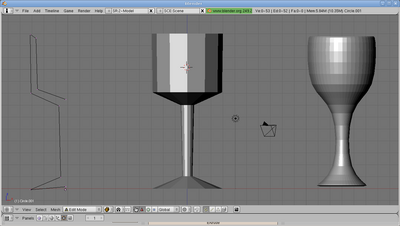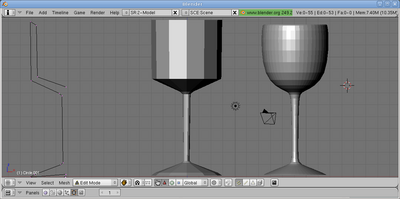Blender 3D:零基础到专业级-单元2:基本建模和着色
Why a goblet? After all, goblets (fancy containers for consumable liquids) are not really all that important in the real world. However, they represent a very large class of interesting objects: those that are radially symmetric. Also, they are fun to play with.
::杯子是什么?毕竟,杯子 (可消耗液体的奢容器) 在现实世界并没有那么重要.然而,它们代表着一个非常大的有趣物体类别:那些是半径对称的.而且,它们很有趣的玩.
To model a goblet and actually see the result, we do the following steps:
::为了模拟杯子并实际看到结果, 我们做以下步骤:
-
create the actual mesh of the object.
::创建对象的实际网格. -
apply a
material
to the object.
::应用一种材料对物体. -
create and light a scene to display the goblet
::创造和照亮一个场景来展示杯子 -
render the scene.
::让我们看看现场.
The following tutorials demonstrate three different approaches to creating the mesh model, and then show two different materials (glass and silver) that may be applied to the goblet. Finally, we add the minimal elements to the scene to permit an "interesting" rendering.
::下面的教程展示了三种不同的方法来创建网状模型,然后展示了两种不同的材料 (玻璃和银) 可以应用于杯子.最后,我们添加最小元素到场景中,以允许一个"有趣"的染.
Three ways to build the mesh
::构建网格的三种方法
As a beginner, you may wonder why we describe three different ways to build the mesh. After all, surely the Pros know of a "best" method?! The answer is that there is not really a best method. Blender provides a sophisticated toolkit, and different blender artists will become familiar with different tools. If, after you gain experience, you become comfortable with cube extrusion, then this may become your preferred tool. If you need more than four vertices per "circle" you may find that cylinder extrusion is better for some particular object. If you are comfortable with "spinning" an object, then spinning may be right for you. All three techniques generate an object that is defined by a set of vertices on a set of circles that are "stacked" on a common axis.
::作为初学者,你可能会想知道为什么我们描述了三种不同的构建网格的方法.毕竟,肯定是专业人士知道"最佳"方法?!答案是,实际上没有最佳方法.混合器提供了一个复杂的工具包,不同的混合器艺术家将熟悉不同的工具.如果在获得经验后,你对立方体挤出变得舒适,那么这可能会成为你喜欢的工具.如果你需要每"圆"超过四个顶点,你可能会发现圆柱体挤出对某个特定的物体更好.如果你对"旋转"一个物体感到舒适,那么旋转可能对你来说是合适的.这三种技术都产生了一个由一个在一个共同轴上"堆叠"的圆圈上的一组顶点定义的物体.
After we build the mesh using one of the three methods, we can apply any number of fancy techniques for texture and rendering. We provide two simple "cookbook" approaches in this section so you can see the result, but materials are treated much more extensively in other sections of the book.
::在我们使用这三种方法之一构建网格后,我们可以应用多种奇特的纹理和染技术.我们在本部分提供了两种简单的"书"方法,以便您可以看到结果,但在本书的其他部分中,材料得到了更广泛的处理.
In the next three sections of the book we describe the "cube extrusion" approach, the "cylinder" approach, and the "spin" approach. Following sections describe three textures that can be applied to objects that are created with any of the approaches, and the final tutorial provides a simple way to render the result.
::在本书的下面三个部分,我们描述了"立方体挤出"方法",圆柱体"方法和"旋转"方法.下面的部分描述了可以应用于任何方法创建的对象的三个纹理,最后的教程提供了一个简单的方法来呈现结果.
The "cube extrusion" approach is a basic technique that all blender artists will become familiar with, to model most types of objects. Since it is such a basic technique, it may become the most efficient way for you to create objects, and you may choose to use it wherever possible rather than switching to a less familiar technique. You can see from the tutorial that this technique is perfectly acceptable for goblets, and by extension it will work for similar objects.
::"立方体挤出"方法是所有混合器艺术家都会熟悉的基本技术,用于模拟大多数类型的物体.由于它是一种如此基本的技术,它可能成为您创建物体的最有效方法,并且您可以选择在可能的情况下使用它,而不是切换到不太熟悉的技术.从教程中可以看到,这种技术对于杯子是完全可以接受的,并且通过扩展它将用于类似的物体.
You may prefer the "cylinder extrusion" technique when you need more than four vertices per circle, because cylinder extrusion is very similar to cube extrusion. Thus your proficiency with cube extrusion will directly carry over to cylinder extrusion.
::当你需要每圈超过四个顶点时,你可能更喜欢"圆柱挤出"技术,因为圆柱挤出与立方体挤出非常相似.因此,你对立方体挤出的熟练程度将直接转移到圆柱挤出.
"Spinning" is conceptually different, even though it creates the same mesh as cylinder extrusion. Spinning is the easiest way to create a radially symmetric model from a two-dimensional description of the cross-section of an object.
::""在概念上是不同的,尽管它与圆柱挤出产生相同的网格.是从对象的两维截面描述中创建一个半径对称模型的最简单方法.
How many circles?
::需要多少圈子?


Each of the three methods defines a set of stacked circles, with vertices equidistant around each circle. The "cube extrusion" technique has four vertices on each circle, while the cylinder and spin techniques have a user-specified number of vertices per circle. But how did we pick the number of circles and the spacing between them?
::三种方法中的每一种定义了一组堆叠的圆圈,每个圆圈周围的顶点均等. "立方体挤出"技术在每个圆圈上有四个顶点,而圆柱和旋转技术在每个圆圈上有用户指定的顶点数. 但是我们如何选择圆圈的数量和它们之间的距离?
The answer is that we know in advance that we intend to use a technique called "subsurf". Subsurf interpolates additional vertices between those we explicitly specify, and this "smooths out" the profile of our goblet.
::答案是我们预先知道我们打算使用一种叫做"潜水"的技术.潜水将我们明确指定的顶点插入其他顶点,
This will cause problems where we need a fairly sharp "bend" in the profile, as between the base and the stem and between the stem and the "bulb" of the goblet. At each point in the profile that has a (fairly) sharp bend, we need for the vertical circles to be close to each other. The two images illustrate this effect. Each image shows an outline of the object, the spun object, and the result after subsurf (level 2) has been applied. The outlines and the spun images are nearly identical, but the subsurfed result is very different, because there are three extra vertices in the second outline: one just above the bottom of the base, one at the top of the base, and one below the bulb: these are the three locations where we need relatively sharp changes in contour. When we spin the outline, the first outline generates seven circles and two degenerate circles, while the second outline generates ten circles and two degenerate circles. Those extra three circles make all the difference. The same phenomenon occurs with the other two modelling techniques.
::这将导致我们需要在轮中相当利的"曲"的问题,例如在底部和茎之间以及在茎和杯子的"球泡"之间.在轮中每个点都有 (相当) 利的曲,我们需要垂直圆圈彼此接近.这两个图像说明了这一效果.每个图像显示了对象的轮,旋转的对象,以及在应用了下面 (级别 2) 后的结果.轮和旋转的图像几乎相同,但下面的结果非常不同,因为第二轮中有三个额外的顶点:一个在底部的底部,一个在底部的顶部,一个在球泡以下:这些是我们需要相对利的轮变化的三个位置.当我们旋转轮时,第一轮产生七个和两个退化,而第二轮